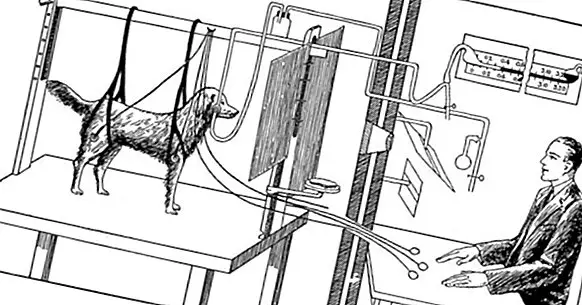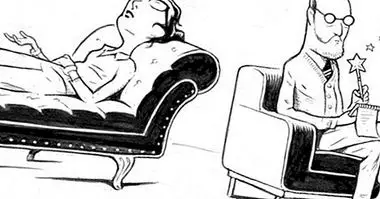Conditioned stimulus: characteristics and uses in psychology
The human being and the rest of animals are active beings, who interact with a medium on which they depend for survival. But why do we do what we do? How do you explain that, for example, when a dog hears a bell starts to salivate or why do we run to seek refuge when we hear an alarm?
This how and why we act as we act is something that has always been of great scientific interest, and that from psychology have studied and researched different theoretical currents. One of them, behaviorism, considers that it is due to a conditioning process. And within this process, the bell or the alarm would be fulfilling the role of conditioned stimulus . It is on this concept, that of conditioned stimulus, about which we are going to talk throughout this article.
- Related article: "Behaviorism: history, concepts and main authors"
What is a conditioned stimulus?
It receives the name of conditioned stimulus all that element that, being initially neutral and not provoking in the person or animal any reaction by itself, acquires the property of generate a response to the association with another stimulus that does generate a reaction .
Using the example used in the introduction, we react with fear to the sound of an alarm not because the alarm generates a reaction in itself but because we know that the sound is linked to the existence of danger or pain (the entrance of an intruder, a enemy attack or fire, for example). In the case of the dog and the bell (part of Pavlov's experiments that gave rise to the study of classical conditioning), the dog will begin to salivate at the sound of the bell as it is associated with bringing food (the sound of the bell being a conditioned stimulus).
This relationship is produced by the capacity of association between stimuli, which the more classical conditioning considered specifically specific to the stimulus itself (although nowadays through other currents we know that other aspects such as will, motivation or cognition influence) .
It is necessary that there is a minimum contingency (that is, that the appearance of one predicts the appearance of another or that they occur to a great extent simultaneously or followed) between the conditioned stimuli and those that have allowed them to become such a thing, the unconditioned stimuli. It is also necessary that the response generated by the latter be strong, and although it is not essential that there may be a relationship between the two.
Virtually any type of neutral stimulus can become conditioned as long as it is perceptible. The perception can come from any channel or sense, being able to be something visual (lights, an image, etc.), sounds (timbres, voices, concrete words, etc.), tactile perceptions (texture, temperature, pressure), tastes or smells . Even in some cases stimuli that do generate a response can be conditioned if they are paired with stimuli that generate a response that is more relevant to the subject.
Also, as we have seen, the conditioning appears in a large number of living beings . It can be seen in humans, but also in dogs, apes, cats, mice or pigeons among many others.
- Maybe you're interested: "Classical conditioning and its most important experiments"
The birth of a conditioned stimulus
Thus, for there to be a conditioned stimulus there must be something that conditions it: the unconditioned stimulus that by itself generates a response. And the relationship that is established between them is what comes to be called conditioning. The birth of a conditioned stimulus occurs in what is called the acquisition phase (in which it acquires the properties that make it go from being neutral to being conditioned).
From the view of classical conditioning, one stimulus is conditioned by another due to the generation of a link between the appearance of the stimulus initially neutral and the unconditioned, which in itself generates an appetitive or aversive response (called unconditioned response).
Little by little and according to they are presented together or in a short interval , the subject is making associations, causing the initially neutral stimulus to acquire appetitive or aversive characteristics and going from not generating a response to generating the same one that generates the stimulus that did provoke a response. Thus, it will end up generating a conditioned response and the neutral stimulus will be considered a conditioned stimulus. From now on, the appearance of the conditioned stimulus will generate the same reaction as the unconditioned stimulus.
With the possibility of extinction
That a stimulus is conditioned and generates a conditioned response can arise on a daily basis or provoked voluntarily, but the truth is that this association will tend to become extinct if the subject observes that the joint appearance of unconditioned and conditioned stimulus stops occurring. Thus, the conditioned stimulus will happen over time to become neutral again and not generate answers .
This process of extinction can be more or less prolonged depending on several factors.
Among them we find how strong the association between stimuli has been or how many times it has been repeated, or if we have learned that the unconditioned stimulus always appears in all the situations in which the conditioner appears or a large part of the time (although it may seem counterintuitive, the association takes longer to become extinct if we are accustomed that both stimuli do not always appear together).
Of course, sometimes it is possible that spontaneous recoveries appear of the association.
Relationship with psychological problems
There are a lot of behavioral problems that are linked to conditioning, specifically with the fact that a stimulus has become a conditioned stimulus and generates a conditioned response.
In general the presence of any fear or even a phobia it can become linked (although a large number of factors and not only these come into play) to this type of association, if a stimulus has been associated with pain or suffering.
So, if once a dog bit us it is possible that we associate any dog with pain, something that will make us afraid of new exposures and avoid them (being the dog the conditioned stimulus). And not only the fear of phobias but also that of post-traumatic stress disorders (for example in people who have suffered a rape may appear fear of sex or people with characteristics similar to the aggressor).
It can also happen in reverse, that we associate something with the pleasure or avoidance of displeasure and excitement or excessive appetite for that stimulus, conditioned. For example, conditioning has been used as an attempt to explain some paraphilias, impulse control disorders, eating disorders or addictions.



















